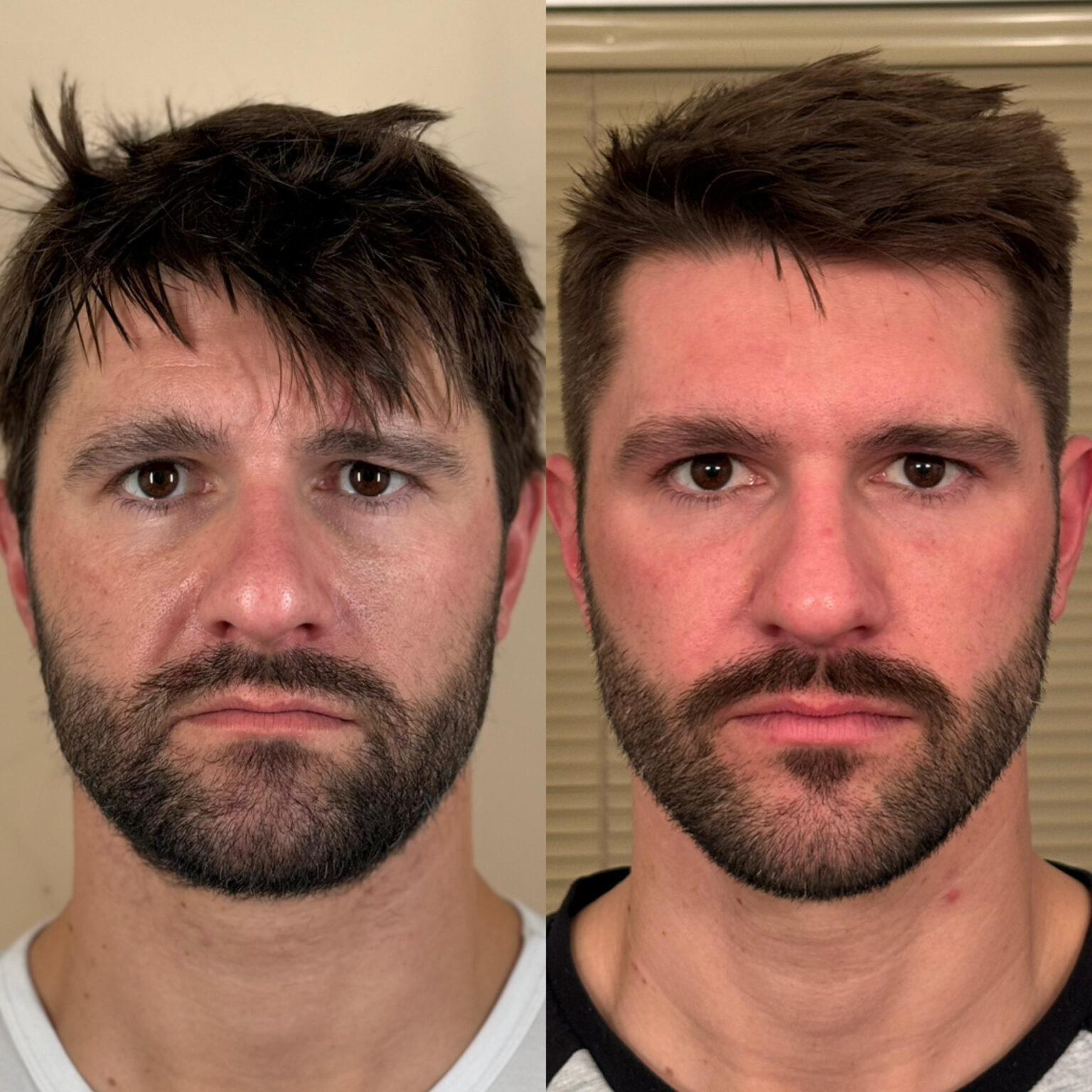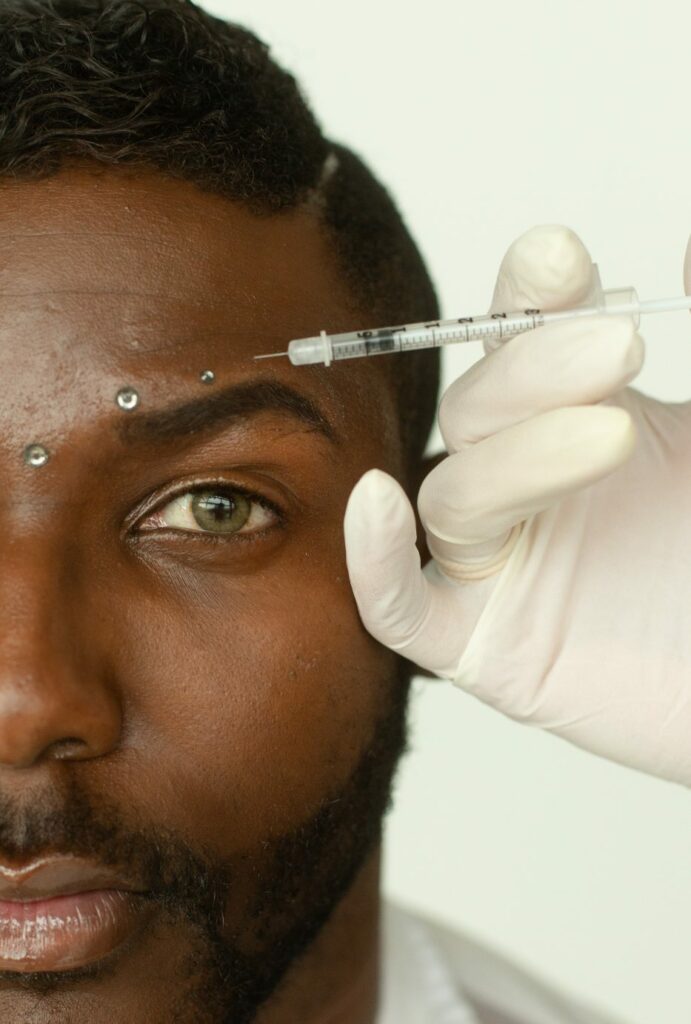Botox for Men: The Trend That’s Becoming the Norm
More and more men have been quietly getting Botox over the past few years, and we believe the trend is here to stay. First impressions matter, and if looking more youthful and rested will boost your confidence and give you the upper hand in your work or dating life, why not go for it?
So yes, if you’re feeling self-conscious about your frown line, get that “Brotox” and rest assured that no one will ever know. In the meantime, we’ll cover everything you need to know about Botox for men in this article so that you’re 100% informed by the time you walk into your first appointment.

What Botox Actually Does (and Doesn’t Do)
Botox is a neuromodulator derived from the botulinum toxin (yes, the one that gives you food poisoning), and its superpower is muscle paralysis. This comes in handy when dealing with contracted muscles that cause deep lines and even jaw clenching. Injecting Botox in targeted areas will selectively relax the muscles responsible for wrinkles while allowing the rest of your face to move naturally.
Once the muscles responsible for deep lines stop contracting, you’ll notice a smoothing effect. However, this doesn’t mean that your wrinkles have gone away permanently. The creasing is still there, just much less visible. That’s the main difference between Botox and filler and where most people get them confused. Filler restores volume, while Botox gives your muscles a rest, making it appear like your lines are gone.
Using Botox regularly also ensures that your lines don’t deepen, which is why some patients like to start in their late 20s or early 30s for prevention purposes.
Here’s what Botox doesn’t do: it doesn’t make your wrinkles worse once the effect wears off. It may look like your lines are deeper, but that’s because you haven’t seen them in a while. So, rather than allowing your lines to fully come back, it’s best to stick to a regular maintenance routine.
Another myth we need to put to rest is muscle atrophy. The relaxing effect of Botox won’t atrophy your muscles, at least not significantly. And if you stop injecting, your muscle function will fully recover. Muscle atrophy happens to all of us as we age, with or without Botox, so why not keep your face looking like your younger self for longer?
How We Get Botox to Look Natural
Can Botox be overdone? Sure. But you can also get too little injected and not see a huge difference. The secret to a natural-looking, masculine face is in the hands of your injector. With the right dosage and precise injection sites for male anatomy, you don’t have to worry about looking frozen and expressionless.
However, keep in mind that animated expressions will be reduced in the injected areas – that’s the trade-off all Botox patients should be aware of. This means you won’t be able to frown quite as much, laugh “with your eyes,” or show other emotions like disgust and surprise the same way you did before Botox. But with a skilled injector, you can still hold onto your natural expressions.
Finding an injector who understands male anatomy is key. Men’s facial muscles are much stronger and thicker than women’s, so more units of Botox need to be injected to achieve the same effect. Male muscles are also inserted differently, so your injector should use male injection patterns to maintain that natural masculine look and avoid any unwanted lifting or heaviness.
Another thing to be aware of is eyebrow position and angulation. Injecting Botox in unwanted areas can cause eyebrow heaviness, but the reverse can also be true – you can get too much brow angulation. Most men don’t want a lifted or arched brow, which can make the face look surprised or feminine. A skilled injector will target the right muscles and use the right dosage to keep the brow straight and natural-looking.
Most Popular Botox Areas For Men
Now that you’ve discovered the wonderful world of Botox, you’re probably wondering what areas you can get treated. We’ll go over the most requested injection sites, plus some areas you may have not thought about.
- Forehead Lines – The frontalis muscle is responsible for the horizontal creases you get every time you raise your eyebrows. Botox will smooth these lines and prevent them from getting deeper.
- Frown Lines (Glabellar or “11” Lines) – The vertical lines between the brows that appear when you frown. Many men are self-conscious about the deep creases in the glabellar area, as they can make them look permanently angry or stressed.
- Crow’s Feet – The fine (or deep lines) lines at the corners of the eyes that form with smiling or squinting. Botox will make these look less visible, but the goal isn’t to completely neutralize them.
- Mouth Area – Includes marionette lines that form between the mouth and cheeks and smoker lines that develop around the lips. These can be treated with Botox or “erased” with filler.
- Chin Dimpling – An overactive mentalis muscle can cause a pebbled or dimpled chin that gets worse with age. A drop of Botox will relax this muscle.
- Neck Lines – Platysmal bands (vertical) and Tech Neck (horizontal lines) can both be significantly improved with Botox, giving the appearance of a rejuvenated neck.
- Jawline & Masseter – Helps define the jawline and reduce bulkiness caused by overactive masseter muscles.

What to Expect During Your First Men’s Botox Session
If you’re new to Botox, it’s normal to feel a bit apprehensive. But don’t worry, you’ll have plenty of time to talk about your goals and ask all your questions. But here’s the reality: most men find the treatment quick, easy, and surprisingly low-maintenance. You can easily fit an appointment into your busy schedule.
Before Your Session
If you’re set on getting Botox, you need to do a little prep. For at least a week before your appointment, make sure to avoid all blood-thinning substances like aspirin, ibuprofen, fish oil, vitamin E, or garlic, as these can increase the likelihood of bruising. You’ll also want to avoid alcohol for at least 24 hours before your treatment (especially red wine) for the same reason.
During Your Appointment
Your injector will take a close look at your facial structure, talk about your goals, and map out a treatment plan that’s designed to keep your features looking as natural as possible. You’ll have plenty of time to ask your questions, as the procedure itself only takes a few minutes.
Once you’re ready, your injector will cleanse your skin, mark the injection points, and use an ultra-fine needle to inject the Botox. You will feel a slight pinch, but honestly, it’s not as painful as it looks. The entire process takes less than 30 minutes the first time, with maintenance sessions typically lasting less than 20 minutes.
Aftercare & Results
If you want your Botox to stay in place, you need to be diligent with your aftercare. For at least 4 hours after your procedure, avoid lying down or napping, any kind of exercise or physical effort, touching or pressing your face, or wearing any mask or helmet that might press on the area. Avoid excessive sun exposure and drinking alcohol for the next 24 hours.
Eager to see results? You’ll notice subtle changes within 3 to 7 days, with full results settling in at the two-week mark. And the best part? Most people won’t be able to tell you had anything done.
How Long Does Botox Last in Men?
The effects of Botox gradually wear off as the body metabolizes the neurotoxin. For most men, Botox lasts between 3 to 5 months, though this can vary a lot.
Men generally metabolize Botox faster than women due to a naturally higher metabolic rate and stronger facial muscles, which means the effects may wear off slightly quicker. Lifestyle habits like frequent exercise, sun exposure, and a high-stress environment can all influence how long Botox lasts in men.
Scheduling maintenance appointments every three to four months will make sure you don’t lose the Botox effects in between sessions. If you feel like your Botox is wearing off too soon, you can always experiment with other neuromodulators such as Dysport or Daxxify.
How Many Units of Botox Do Men Need?
There’s no way to determine exactly how much Botox you’ll need—it depends on the area being treated, how strong your facial muscles are, and how subtle or deep your lines are. However, keep in mind that men typically need twice the amount of units compared to women. [1]
Here’s a breakdown of the range of Botox units needed for various areas [2]:
- Forehead lines: 20-60 units
- Frown lines (glabellar lines): 20-50 units
- Crow’s feet: 15-30 units per side
- Chin dimpling: 10 units
Wondering about the cost? If you know which area you want to get treated, you can multiply that number by the average cost per unit to get a ballpark range. Better yet, book a consultation for a personalized assessment.
Dysport vs Botox. Which is Better For Men?
Both Dysport and Botox are patient favorites here at The Luxe Room, and while they work a little differently, both neuromodulators will achieve the same thing. Here’s why some patients may prefer one over the other:
- Onset time – If you’re a little impatient, know that Dysport kicks in faster and settles in one week, while Botox takes twice as long to work, and results won’t be final until the two-week mark. If you have an upcoming event or vacation, Dysport may be the way to go.
- Longevity – some patients swear by Dysport and claim that it lasts longer, but the longevity of both Botox and Dysport will vary greatly according to your metabolism, muscle strength, and lifestyle. As a general rule, both neuromodulators last anywhere from 3 to 5 months.
- Cost – If you’re tempted to choose Dysport because it’s more affordable, think again. While Dysport is priced lower per unit, the overall cost evens out since you need about three units of Dysport to match a unit of Botox.
Botox or Dysport – which one is right for men?
No single neuromodulator is proven to be more effective on men’s muscles than others. All neuromodulators, whether it’s Botox, Dysport, Daxxify or Xeomin, work the same way in both men and women.
What About the Side Effects?
Botox is one of the safest cosmetic injections, FDA-approved for decades and extensively studied since the 1980s, thanks to its numerous medical applications. But like any procedure, it comes with potential risks.
Mild and temporary side effects include minor redness, bruising, or swelling at the injection site, which should fade within hours or a few days. Some men experience a slight headache or tightness in the treated area.
Botox can cause temporary muscle weakness or asymmetry if it spreads beyond the intended area or if injected improperly. This is why it’s so important to see an experienced injector who understands male facial anatomy. Don’t forget to do your part and stick to aftercare instructions to help the product stay in place.
Other Treatments Paired with Botox for Men
Botox smooths out wrinkles, but pairing it with other treatments can make a huge difference. The most popular combination is Botox to reduce lines and filler to restore volume. Sculptra is a game changer for combatting hollows and dark circles by promoting your bodys own natural collagen production, boosting definition without looking obvious. Jawline sculpting with dermal filler is another option if you’re into that athletic, chiseled look.
If you need help with skin texture, Moxi Laser & microneedling is a godsend and even better for men struggling with acne scars and rough patches. Or you can consider PRP therapy, which uses your own plasma to boost collagen and improve skin quality. Keep in mind that you’ll have to space these procedures apart so that they don’t interfere with your Botox placement.
Let’s Chat!
If you’ve been thinking about Botox but weren’t sure where to start, now’s the time to find out. Book a consultation, and let’s talk about what works for you. We offer both Botox and Dysport (our crowd faves), plus a multitude of treatments designed to refine, refresh, and enhance – all designed to keep you looking youthful but still you.



